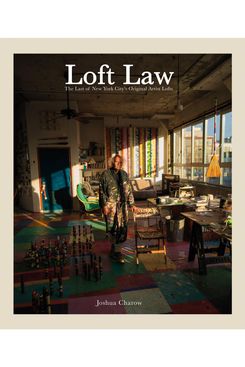Brooklyn Artists and Loft Law


Photo: Joshua Chorow
Jennifer Charles, the singer-songwriter who is half of the band Elysian Fields, nearly left New York City in 2001. Her lease had ended, and she was looking at shoebox after shoebox when she found a Victorian home upstate. Just before she decided to move, she got a call from a scientist friend who had decided to leave their Greenpoint loft. Charles made the decision to move into the raw, top floor, corner space where she continues to live with her partner, author Lance Scott Walker, and their two cats.
Charles’ loft is in an industrial corner of Greenpoint that managed to stave off gentrification until just a few years ago. Today, her building is now surrounded by glass towers. “In the 1930s, when it was built, this building was a rag factory. Back in the day, a rag man would go down the street and collect rags from people. Your old torn clothing, your dirty things, it was really about reusing and recycling and repurposing things. They would collect them from the neighbors, and then they would all be processed in the factory, and then everyone would have rags for what they needed.”
Her feelings towards Greenpoint of the early 2000s are reminiscent of older artists’ feelings for the Tribeca of the 1970s: “There was something about it that captured the imagination. This whole area was just completely a no-man’s land. It was very industrial. There were not even streetlights. I loved that you could just be down here and not run into anybody you would know. It was very special, and that lasted for [quite some] time. I can’t even remember when that ended, but it hasn’t been like that for a long time. Then, of course, Bloomberg sold the city up the river, and then all the subsequent mayors have done things just to have high rises in real estate and be in cahoots with the city council. They’re all scratching each other’s backs.”
The loft has been an instrumental part of Charles’ musical process. “We’ve had rehearsals here, we’ve had salons here, we’ve filmed music videos here, we’ve filmed music videos on the roof, we’ve done photo shoots here, it goes on and on. Of course, many songs and albums have been written here. There’s something so essential for me to be able to create at any time, in any moment that I want. If I wake up at night with a song, which often happens, I can just start working on it. And that’s very, very special.”
Photo: Joshua Chorow
Around the late 2000s, artists and loft tenants across Brooklyn started to pursue the same fight as the original Manhattan tenants did in the late 1970s. After organizing, staging rallies, and again visiting Albany, the Brooklyn tenants won an amendment to the Loft Law in 2010 to expand Loft Law coverage to Brooklyn residents. It also created a new window for any loft tenant to gain coverage by proving they lived in a commercial or manufacturing-zoned space for 12 consecutive months from 2008 to 2009. Charles and many others who arrived after 1982 gained Loft Law coverage under this new amendment to the law.
Like others I interviewed, Charles says leaving this loft would mean leaving New York. “I don’t want to leave it because it continues to be a haven. If I had to leave this place, I would probably leave New York—and that’s the honest truth. It’s really a special community. Without sounding glib about it, it’s a sacred thing. We’re an endangered breed—being an artist in New York.”

Source link





